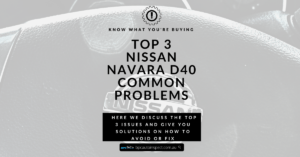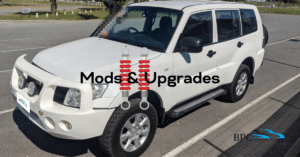Here are two common Mitsubishi Triton problems to be aware of before you buy or do preventative maintenance and avoid costly repairs.
In this article
Two Common Mitsubishi Triton Problems:
Faulty EGR Valve
The Exhaust Gas Recirculation (EGR) valve can contribute to intake clogging in certain vehicles, including some models of the Mitsubishi Triton. The EGR system is designed to recirculate a small amount of exhaust gas into the engine’s intake manifold. This process helps reduce nitrogen oxide (NOx) emissions, which is good for the environment.
However, the recirculated exhaust gases contain carbon particles and other contaminants, which can lead to the buildup of carbon deposits in the intake system of a diesel engine over time. The EGR valve, responsible for controlling the flow of exhaust gases into the intake manifold, can sometimes malfunction or become clogged. When the EGR valve fails to close or gets stuck in the open position, too much exhaust gas may enter the intake manifold, contributing to increased carbon deposits.
Symptoms of a Faulty EGR Valve Causing Intake Clogging:
- Rough Idling: An EGR valve that is stuck open can disrupt the air-to-fuel ratio, leading to rough idling and engine stalling.
- Reduced Engine Performance: Clogging of the EGR valve or too much recirculation can cause a drop in engine power and torque.
- Check Engine Light (CEL): A malfunctioning EGR valve can trigger the check engine light on the dashboard, indicating a problem that needs to be diagnosed.
- Increased Emissions: If the EGR valve fails to function correctly, it may lead to higher nitrogen oxide (NOx) emissions, potentially causing your Triton to fail emission tests.
- Buy an oil catch can kit* (eBay affiliate link). They are readily available and inexpensive to buy from eBay for turbo diesel engines. Also, see my Ryco Catch Can review.

Solution:
If you suspect that the EGR valve is causing intake clogging or other related issues in your Mitsubishi Triton, it’s essential to have the vehicle inspected by a qualified mechanic. They can diagnose the EGR system and check for any clogs or malfunctions. Depending on the severity of the problem, the mechanic may recommend one of the following solutions:
- EGR Valve Cleaning: The EGR valve may be clogged with carbon deposits. Cleaning the EGR valve and its passages can resolve the issue.
- EGR Valve Replacement: If the EGR valve is irreparably damaged or clogged beyond cleaning, the mechanic may suggest replacing the valve with a new one.
- EGR System Inspection: The mechanic will also inspect the EGR system’s components, including the EGR cooler, for any leaks or malfunctions that may contribute to excessive carbon buildup.
Thinking of Deleting or Disabling the EGR Valve?
Here’s what they say over at Unsealed 4X4:
Some folks will tell you the best thing to do is disable the EGR valve by blocking it off. That stops the soot from mixing with the oil-fumes, but it’s illegal to tamper with the emissions controls on a motor vehicle, so you’re leaving yourself open to lots of legal and potential insurance hassles. Not to mention what Mitsubishi would do with your warranty if there’s a claim down the track.
The manufacturer recommends regular maintenance and cleaning of the EGR system. This helps to prevent severe intake clogging caused by the EGR valve. Additionally, using high-quality fuel and following proper driving habits can aid in reducing carbon buildup and maintaining the overall health of the engine and intake system.
Rust in Front Support




There have been reports of rust developing in the front support of some Mitsubishi Triton MQ models. The front support (intrusion bar) behind the front bumper is a critical component of the vehicle’s suspension, and if it rusts through, it can cause the suspension to collapse. This can be a dangerous situation, leading to loss of control of the vehicle.
The images from a 2016 Mitsubishi Triton GLS MQ Auto 4×4 MY16 Double Cab done 140,000km on a used car inspection by BPC Auto Inspect. The comments in the CarSales advertisement read:
LOVELY 1 OWNER EXAMPLE
4x Brand new Dunlop AT Tyres
High Gloss Black 17 Inch wheels
2 keys, full-service history
Soft Tonneau Cover and Alloy Lader racks
Ready for Work or Play!
The rust issue is thought to be caused by a combination of factors, including the use of low-quality steel in the front support, exposure to road salt, and poor drainage. If you plan on using your 4WD for the intended purpose think about rust-proofing the underbody. One of the Mitsubishi Pajero issues is surface rust which can lead to structural rust if no rust protection is added.
If you own a Mitsubishi Triton MQ, check the front support for signs of rust. If you see any rust, you should have it inspected by a qualified mechanic.
Here’s a thread discussing chassis rust over at Mitsubishi Forums:
Hi looking for an idea of what to try next I have a 2016 Triton 4×4 it has never been near the beach but has loads of chassis rust and the intrusion bar behind the front bumper is flaking.
Here are some tips to help prevent rust in your Mitsubishi Triton MQ Dual Cab Ute:
- Wash your vehicle regularly, especially in areas where road salt is used.
- Apply a rust-proofing product to the front support. There are plenty of aftermarket products available on eBay
- Keep the drainage holes in the front support clear of debris.
Suppose you are concerned about the rust issue in your Mitsubishi Triton MQ Dual Cab Ute. In that case, you can contact Mitsubishi customer service for more information.
*Some links in this post are affiliate links, which means we may earn a commission at no extra cost to you. Please refer to our disclaimer for more info.




